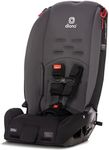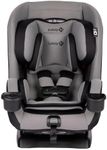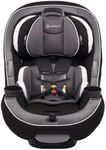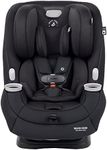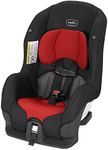Buying Guide for the Best Rear Facing Toddler Car Seat
Choosing a rear-facing toddler car seat is an important decision for your child's safety and comfort during car rides. The right car seat will not only protect your child in the event of an accident but also make everyday travel easier for you. When shopping for a rear-facing car seat, it's essential to consider how it fits in your vehicle, how easy it is to install and adjust, and how well it will accommodate your child as they grow. Understanding the key features and specifications will help you make a confident and informed choice.Weight and Height LimitsThe weight and height limits indicate the maximum size your child can be to safely use the car seat in the rear-facing position. This is important because keeping your child rear-facing for as long as possible is recommended for safety. Car seats come with different ranges: some are suitable for infants only, while others can accommodate toddlers up to higher weights and heights. If you want a seat that lasts longer, look for higher limits, but always check that your child fits within the recommended range for both weight and height. Consider your child's current size and growth rate to choose a seat that will serve you well over time.
Installation MethodCar seats can be installed using either the vehicle's seat belt or the LATCH system (Lower Anchors and Tethers for Children). The installation method is important because a properly installed seat is crucial for safety. Some seats are easier to install with one method over the other, and not all vehicles support both methods in every seating position. If you plan to move the seat between cars or want a quick, secure installation, look for seats with clear instructions and features that make installation easier. Always check your vehicle's manual to see which installation methods are supported.
Adjustability and Recline PositionsAdjustability refers to how easily you can change the harness height, headrest, and recline angle of the car seat. Recline positions are especially important for rear-facing seats to ensure your child is comfortable and their airway remains open. Some seats offer multiple recline options and easy-to-adjust harnesses, which can make daily use much simpler. If your child often naps in the car or if your vehicle's seats are sloped, look for a seat with more recline options and easy adjustability to keep your child safe and comfortable.
Size and Fit in VehicleThe size and shape of the car seat affect how well it fits in your vehicle, especially if you have a smaller car or need to fit multiple seats in the back. This is important because a seat that is too large may not install correctly or may make it difficult for other passengers to ride comfortably. Measure your back seat and compare it to the car seat's dimensions. If you have a compact car or need to fit more than one car seat, look for narrower models or those designed for smaller spaces.
Ease of CleaningToddlers can be messy, so the ease of cleaning the car seat is an important consideration. Some seats have covers that are easy to remove and machine washable, while others may require more effort to clean. If you anticipate frequent spills or accidents, look for a seat with a removable, washable cover and minimal crevices where crumbs can get stuck. This will make maintenance much easier and keep the seat hygienic for your child.
Safety FeaturesSafety features include things like side-impact protection, energy-absorbing foam, and a five-point harness. These features are important because they provide extra protection in the event of a crash. Some seats offer enhanced safety technologies or additional padding. When choosing a seat, look for those that meet or exceed safety standards and consider any extra features that might give you peace of mind, especially if you drive frequently or on busy roads.


